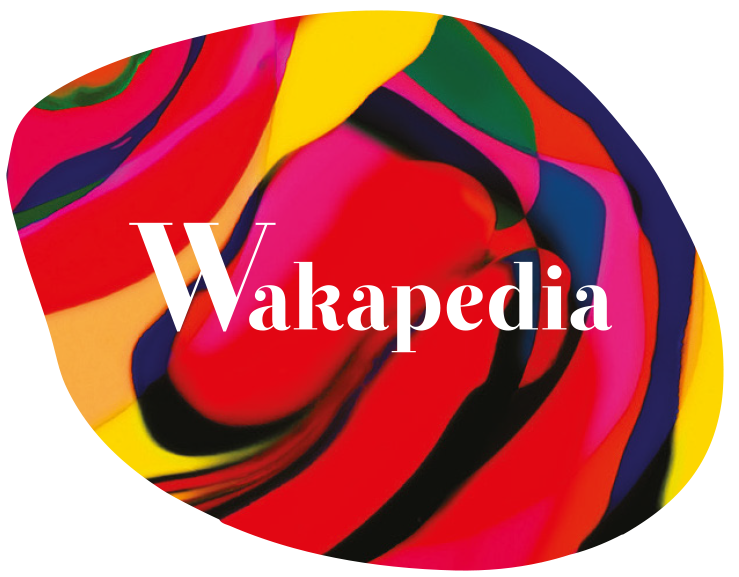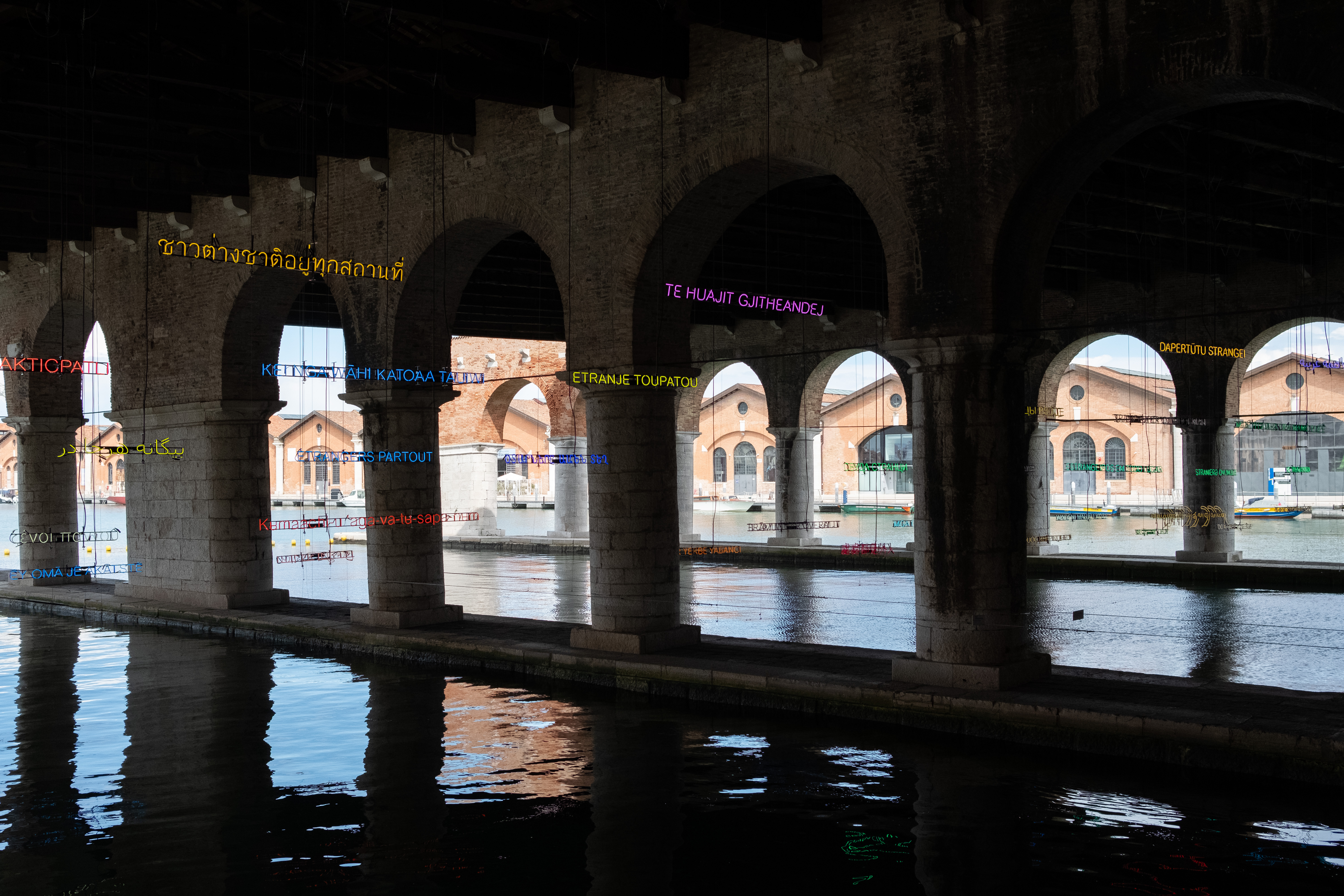The 60th edition flies the flag of global inclusiveness and openness.
The Venice Biennale is undoubtedly our favorite art event. We jump at the chance to go back every two years not only because the city is filled with fresh, super-creative, and international energy or because we immerse ourselves in spectacular exhibitions until our eyes, feet, and brains ache but also because the Biennale is an opportunity to continue the discussion about current events. Our transformative conversations with other visitors, artists, and curators from all over the world always make us question our assumptions and change our point of view. In Venice, we feel even more alive, open, and immersed in a global, borderless culture–which is really the guiding principle behind all our projects a Wakapedia.
This year, of course, we were very moved by the Biennale’s central exhibition theme: Strangers Everywhere. Under this title, borrowed from a work by the Claire Fontaine collective (2006), Brazilian curator Adriano Pedrosa brings together more than 330 artists of dozens of different nationalities, many of them from the Global South who have never participated in the event before, and others who respond to the term “foreigner” in its many meanings: marginalized, immigrant, refugee, exile, expatriate, Indigenous, and queer.
This inclusive and open-to-the-world edition perfectly represents the multiple nationalities and cultures of the Wakapedia team. We are French, Italian, Japanese, and American… and are mostly expats in other countries; we feel simultaneously at home everywhere but a little bit foreign everywhere –in a good way! For us, being a foreigner means having the opportunity to confront other cultures, to change perspective, and to look at the world with different, bigger eyes; in short, being a stranger everywhere is an asset and not a flaw! We found this vision in many of the pavilions and all around us at the event. We were amazed, amused, and excited… Here is our very own TOP 5 of the Venice Biennale 2024.
GERMANY
The queue at the entrance reveals that the German Pavilion is undoubtedly the most popular of the Biennale! Entitled Thresholds, the exhibition curated by Çağla Ilk that brings together works by Turkish-born German director Ersan Mondtag and Israeli artist Yael Bartana, delves into the concept of “thresholds” as both a point of no return and a passage to another dimension. Both works project us into a futuristic, dystopian world with space stations drifting in the void, sleepwalking characters, and rumbling noises. Vegetation is artificially cultivated in glass greenhouses because the earth is now a heap of formless matter–much like the mountain of dark soil that engulfs the outside of the pavilion to create the illusion of a tomb. In the central hall of the pavilion, Ersan Mondtag imagined a multi-story structure with a spiral staircase. This construction serves as the set of Monument of an Unknown Man, a performance-installation. One of the five actors plays Mondtag’s grandfather, who emigrated to Germany in 1968 and died there of cancer after working in an asbestos factory.
This disturbing but fascinating piece invites us to reflect on the possibility of collective transformation and imagine a different future.
WAKAPEDIA ENTERTAINMENT AWARD
What can we say? We loved this pavilion! We felt like we were in a post-apocalyptic version of Berghain, Berlin’s trendiest nightclub—a sci-fi and dark rave party pavilion… very representative of the underground vibe of the German capital. The actors’ performances in the tower gave us chills of anguish but also inspired wonder! It is an undoubtedly original and out-of-the-box contribution. Another remarkably positive point is that bringing together a German director and an Israeli artist is a potent symbol of solidarity between peoples, particularly apt at this historical moment!
JAPAN
For her installation entitled Compose, Tokyo-based artist Yuko Mohri was inspired by the devices employed in the Tokyo subway system to contain water leaks. In a suspended and poetic, yet slightly distressing atmosphere, the work resembles a giant mechanical apparatus where water is collected and diverted along unpredictable paths through various contraptions: pipes, light bulbs, fruit, pumps, and furniture. The space is permeated by an array of odors, lights, and sounds, enhancing the immersive experience. Electrodes connected to some of the fruit transform moisture into electrical impulses that power lightbulbs. The intensity of the light and sounds decreases as the fruits wither. This work symbolizes how, in emergencies, community collaboration can help find ingenious and original solutions to overcome crises.

WAKAPEDIA ECO-FRIENDLY AWARD
We preface this by saying that this pavilion seemed off-topic perhaps because the Japanese do not particularly appreciate having foreigners everywhere?! (Bad joke by Waka) Despite this, we chose to highlight the installation because, while it appears whimsical and reminiscent of Miyazaki’s Howl’s Moving Castle, it is a metaphor for a serious issue: the importance of water conservation and the risk of drought.
AUSTRALIA
In this solemn pavilion, aboriginal Australian artist Archie Moore drew an enormous genealogical chart of his Kamilaroi and Bigambul ancestors using chalk over a period of several months. His complex “holographic map” fills the blackboard walls from floor to ceiling to trace more than 2,400 generations back over 65,000 years.
In stark contrast to the dark surroundings, neatly stacked reams of white paper cover a large white table in the center of the room. Each sheet is a coroner’s report, documenting the countless deaths of Aboriginal people in Australian prisons. Two shocking statistics underscore this issue: although Aboriginal people make up only 3 percent of the total population, they account for 40 percent of the prison inmates, a clear sign of systemic discrimination against this community.
This installation simultaneously about the history of Australia and also the artist’s familial heritage and personal narrative. It highlights numerous dramatic episodes and atrocities inflicted on Aboriginal communities, including the decline of Australian dialects due to colonization. The words in the title of the work, Kith and Kin, originally meant “countryman” and “homeland,” but over time have evolved to commonly mean “friends and relatives.” This shift underscores the ambivalence between evolution and disappearance, and the necessity and fragility of historical memory.

WAKAPEDIA EMOTION AWARD
We were not the only ones who appreciated the Australian Pavilion. It won the Golden Lion this year because the project resonates deeply on several levels: family, heritage, discrimination, personal history, and collective memory. This profound and moving work serves as a contemporary memorial, inviting reflection on the massacres affecting ethnic minorities in Australia and around the world. It moved us to tears!
POLAND
Curated by Marta Czyż, Poland’s pavilion, much like the country itself, welcomes Ukrainian refugees this year. The pavilion features artists Yuriy Biley, Pavlo Kovach, and Anton Varga, who together form the Open Group collective. They present a simple yet intense video installation addressing the trauma of conflict. Filmed in close-up, various men and women reproduce the sounds of war with their voices: sirens, missiles, and explosions. The installation, entitled Repeat After Me II, underscores the crucial need for populations in war-torn regions to recognize these sounds for survival. Additionally, the work is interactive, inviting viewers to “sing” these terrifying sounds into microphones placed in the darkened hall, creating a poignant karaoke of war.

WAKAPEDIA POLITICAL ART AWARD
Preface: It’s not just because our Japanese team loves karaoke that we placed this pavilion in the Top 5! Open Group’s offering is a timely work that helps us understand the ordeal experienced every day by Ukrainians, who now learn to “sing” the sounds of war rather than the latest international hits. We found the idea of inviting the audience to interact through microphones both relevant and symbolic. While it might initially seem playful, this device serves as a powerful metaphor that can be interpreted in two ways: stepping into the shoes of refugees or rebelling against the situation by taking a stand.
We returned to the pavilion several times and were struck to find that the visitors’ behavior was always the same. When their turn came, no one could bring themselves to speak into the microphones, and a profound silence enveloped the dark room. Was it fear of expressing themselves? Indifference? A sense of guilt? This inaction left us puzzled and reflective.

BELGIUM
The art collective Petticoat Government offers a captivating multimedia experience centered around seven towering effigies crafted from wicker and a medley of materials sourced from Belgium, France, and the Basque Country. These vibrant and imposing figures, drawn from the folklore of diverse communities, are on a transhumance journey. They will rest in Venice for several months before continuing to Charleroi and Dunkirk. Combining different visual languages, contemporary mythologies, and ancient folk tales, the artists want us to rethink the concept of national borders and enhance solidarity and collaboration between different cultures and populations.
WAKAPEDIA GOOD VIBES AWARD
After visiting dozens of exhibitions with serious themes and conceptual works, arriving at the Belgian Pavilion was a delightful respite for our minds! We loved the festive atmosphere, where tribal music and drove a dance party under the giant effigies who—even if they don’t move–seem to appreciate the good vibes of the audience. Just like us!













